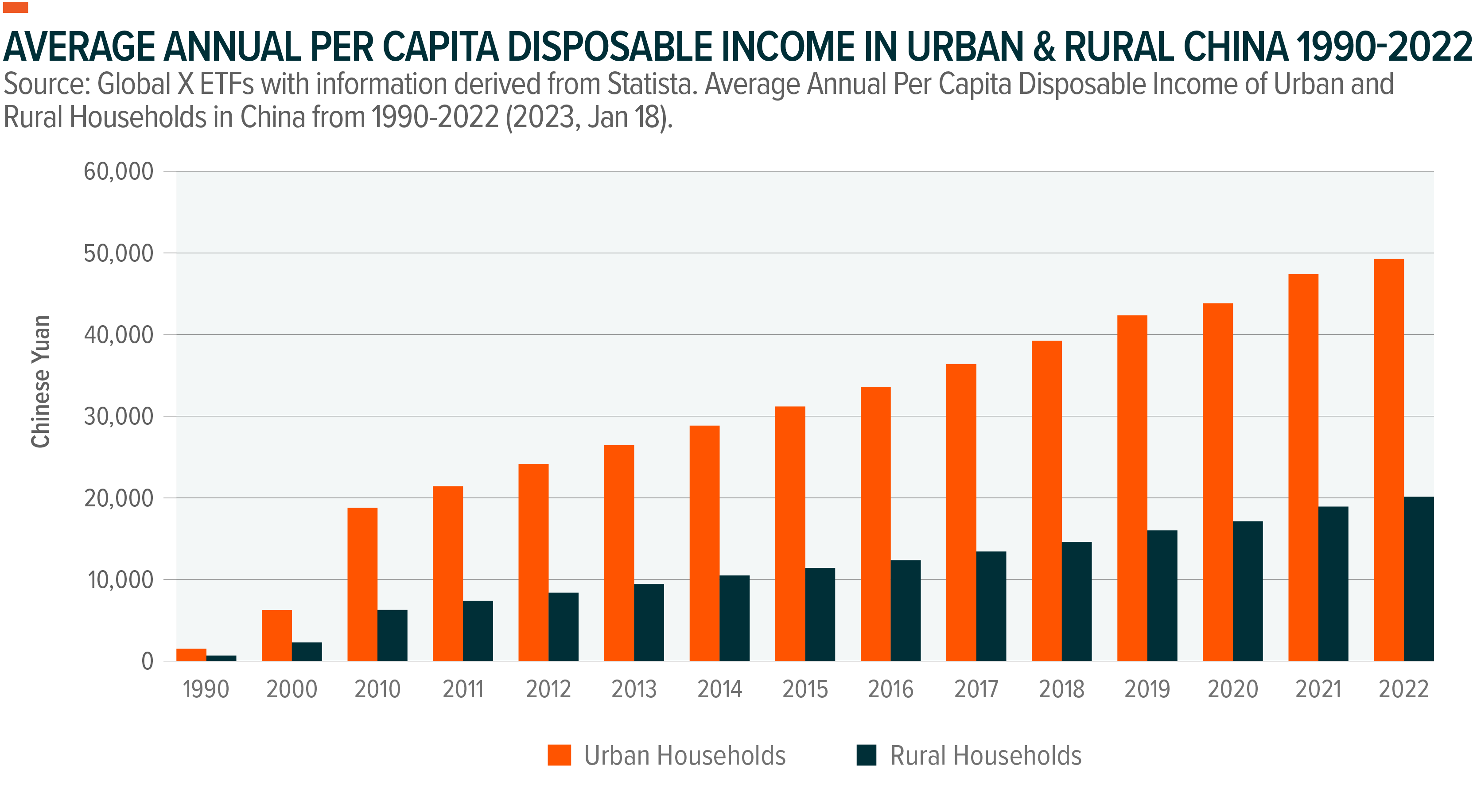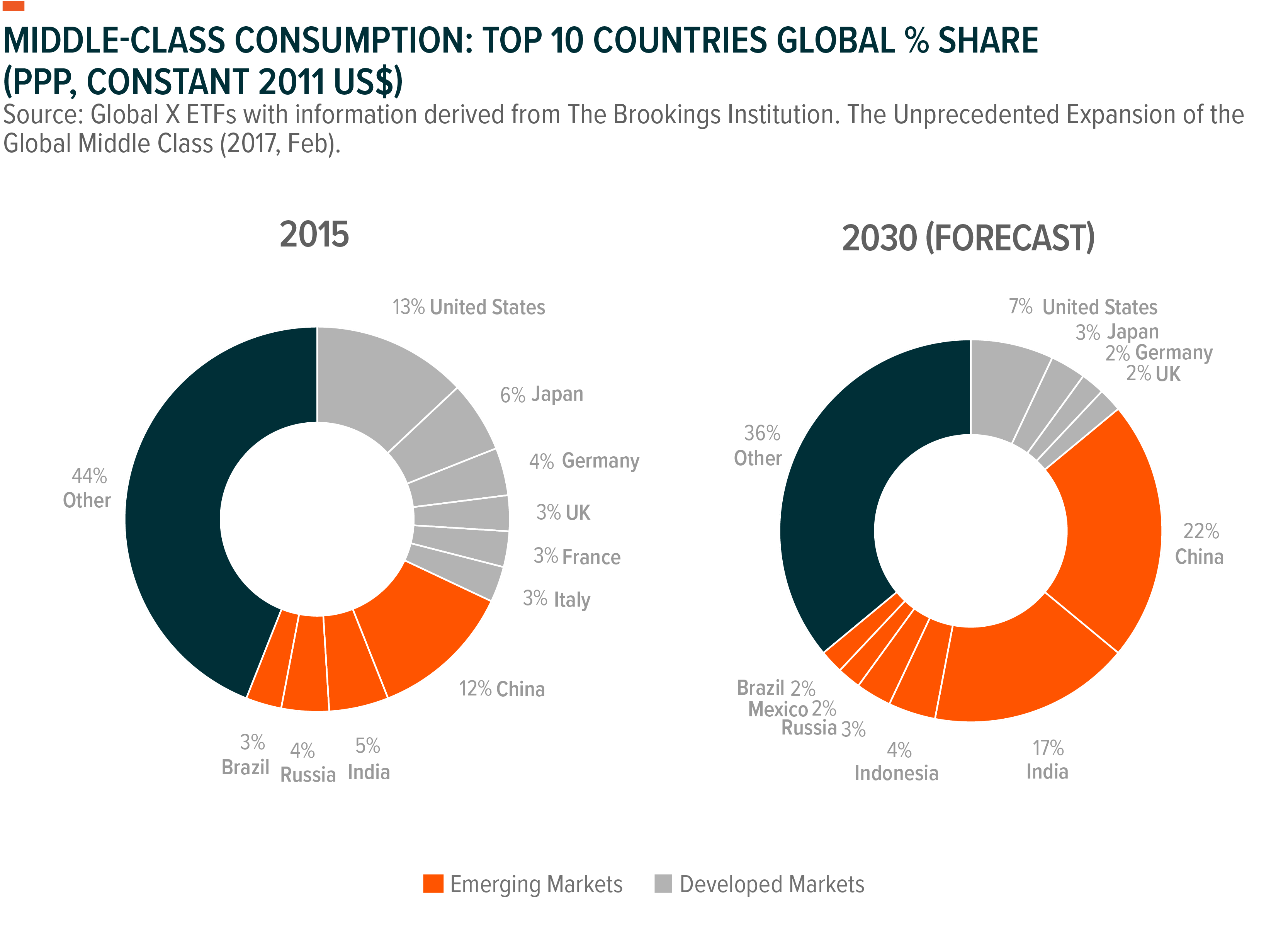China’s policy pendulum historically swings from tightening to loosening over a shorter time horizon versus typical US/European cycles. This reflects the Chinese Communist Party’s (CCP) desire to control the economic backdrop and deliver consistent economic growth. Given its far-reaching powers, the Chinese government has multiple levers beyond traditional monetary and fiscal policies, which means the market should not underestimate the CCP’s recent broad economic pivot and its impact to China’s equity market.
The 20th CCP Meeting Outlines a Five-Year Blueprint for China’s Economic and Social Development
- Stability: Overall, the Party Congress report emphasized continuity. A lack of dramatic changes is generally perceived as good news.
- Middle-Class Growth: President Xi Jinping said that per-capita gross domestic product (GDP) would rise to the level of a “medium-developed country” in a “giant new leap” by 2035.1 Economists assess that would mean doubling GDP and per-capita income, with an average annual GDP growth rate of roughly 5%.2
- Evolving GDP Inputs: The goal here appears to be strengthening the fundamental role of consumption in economic development and the key role of investment in optimizing the supply structure.
- Market Support: Xi laid out goals to consolidate and develop the public sector economy, while at the same time encouraging, supporting, and guiding the non-public sector economy.
- Technology and Innovation: Xi emphasized “invigorating China through science and education.”3
Common Prosperity
Common Prosperity is a Chinese Communist Party political slogan historically meant to encompass programs dedicated towards wealth redistribution and social equality. This has been a major talking point for the current CCP leadership. The policy has evolved from traditional communist connotations to one focused on boosting GDP per capita across China and lifting the country via balanced and sustainable growth. The bottom line is that China’s success depends on GDP expansion, and the country needs new drivers of growth.
Evolving GDP Growth Drivers
GDP = Private Consumption + Government Spending + Private Investment + Net Exports
Government spending cannot last forever; Exports (as a % of GDP) should diminish, as countries do not want to rely on outside forces; and Private Investment is dependent on business cycles. That leaves Private Consumption as the primary piece emerging market (EM) governments have left to control in order to drive GDP expansion. With roughly 68% of GDP growth coming from private consumption, the US has set a model for a sustainable economy.4 China (where private consumption accounts for roughly 38% of GDP) has watched, learned, and begun to emulate this model.5
China’s policy objective of Common Prosperity provides a clear example of this shift to private consumption as the key driver of sustainable growth. China has experienced tremendous economic growth, but it has come with a rise in social inequality and economic disparity. Common Prosperity is a development plan aimed at promoting domestic-oriented long-term growth.
The Chinese government understands that it must move its economy up the value chain, create higher-paying jobs, grow its middle class, and improve growth through consumption. This starts with moving capital allocations away from construction and low-level manufacturing to higher value-add production.
Moving Beyond Real Estate, Exports, and Simple Manufacturing
Real estate, exports, and simple manufacturing represent China’s old growth drivers. Property investment grew every year from 1999 (when records began) through 2021, with 2022’s 10% year-over-year decline ending the streak.6 Homeownership rates have surged, sitting at nearly 90% in 2018, much higher than developed economies like the US, Japan, and South Korea.7 However, this growth should taper. In terms of exports, the world is seemingly moving towards isolationism and protectionism, meaning China will need to depend less on export-led growth. Last, manufacturing should also diminish, as China cannot sustainably serve as the cheap source of labor for the rest of the world.
Virtuous Growth Cycle Could Be Emerging
With old economy sectors providing less forward-looking ammunition to drive GDP growth, China’s government has shifted its focus to technology and sustainability. Investments in these areas ought to help drive growth on their own, but they should also drive higher wages, leading to increased domestic consumption, which creates a virtuous cycle. This cycle should make up for the slowdown in exports, real estate investment, government spending, and low-end manufacturing. With falling birth rates, China sees fewer annual new workers enter the labor force. The government understands that a sustainable future requires a shift from quantity to quality. That means increasing value and productivity similar to what other countries did through the 20th century. Over the next five years, 50 million graduates are set to enter the workforce in China, more than the US, Germany, Japan, Korea, and Southeast Asian countries combined.8 The playbook is there, and China’s increasingly educated workforce is well prepared for this transition.
Education and Government Reforms Poised to Grow the Middle Class
A highly educated population plus a government that is investing in value-add technology likely equals higher-paying jobs and a growing middle class. Increasing levels of urbanization should also boost the country’s middle class. Urban disposable income is over 2.4 times higher than the rural level.9 China’s urbanization rate is around 61%, compared to over 80% in the US, the UK, South Korea, and over 90% in Japan.10 With that said, reform to “Hukou” (a registration system that allows registrants to receive various government benefits) represents another driver for middle-class consumption, as it should incentivize migrant workers to re-establish themselves in cities. Easing the system could provide some 375 million migrant workers, a group larger than the US population, access to social welfare and raise their propensity to consume.11 Migrant workers without “Hukou” have a savings rate higher than that of urban workers – so they are spending less.12 This change could help drive urbanization and consumption going forward.

A Larger Middle Class Should Drive Private Consumption
A fast-growing middle class translates into consumption playing a larger role in future economic growth. China’s middle class recently represented roughly 400 million people, less than one third of its population.13 If annual income growth were to average 6.5%, which seems plausible with 5%-6% GDP growth, our calculations suggest that the middle class could represent over 45% of the population by 2035. Policy changes towards lowering inequality should help this trend, as well. If inequality declines and China’s Gini Coefficient moves from the 2021 level of 0.466 to 0.400, then the middle class could grow to roughly 50% of the population.14 As China’s middle class expands, so too should private consumption as a percentage of GDP. Such a shift in private consumption would likely change the GDP equation and create profitable and sustainable growth going forward – similar to the US.

Structural Transformations Augur Well for Long-Term Growth
China’s growth is evolving, but this is still the most potent backdrop in the world. China is now the second-largest spender on research & development (R&D) in the world, behind only the US, and accounts for over 20% of global R&D spending.15 China plans to increase its R&D spending by more than 7% per year between 2021 and 2025.16 The country has topped the rankings in global patent filings since 2019 and now ranks 11th in the global innovation index.17 The share of the population with a university degree exceeded 15% in 2020, up more than 65% from ten years ago, with many of those graduates in science, technology, engineering, and math (STEM) fields.18 Investment is not stagnant but is shifting towards innovation in higher-end manufacturing and green projects. Combine this with the rapidly expanding middle class, and we expect China to sustain 5%-6% GDP growth in the coming years. We are witnessing a population of over 1.4 billion people moving from simple manufacturing to innovation, technology, and services. This powerful transformation could drive the Chinese economy for generations to come.
Getting Beyond Recent Covid Concerns
Zero-Covid: In a matter of weeks, China recently moved on from its Zero-Covid policies and reopened its economy. The government seemingly dropped all signs of its Zero-Covid policy and allowed the virus to sweep across the country. Though contagion spread quicker than expected, it is highly likely that Covid cases had peaked by the New Year holiday. On January 8, 2023, travel company Ctrip said that applications via its site for tourist visas for Singapore had risen over 30 times since December 27, 2022.19 The Tourism Authority of Thailand forecasts Chinese visitors to hit at least 60% of pre-Covid numbers this year.20
Property Sector: China has relaxed its “three red lines” policy on housing, which imposed tighter restrictions on the real estate sector.21 The government has urged banks to extend repayment deadlines for loans used to build housing by a year. Regional governments were also told to lower the floor for mortgage rates. The government has also allowed cities to lower mortgage rates and pledged to strongly support first-home demand and reasonably support second-home demand, while third-home demand should theoretically not be supported.
Regulation: High ranking officials within the government have declared that the two-year “rectification” of large tech companies has basically been completed, and what will follow now is “normalized supervision,” so that tech companies can lead development, create jobs, and compete internationally.22,23 However, is regulation necessarily a bad thing? China’s anti-monopoly laws were first passed in 2007. This is over a century after the US Sherman Act of 1890 and well after the Clayton Acts and Federal Trade Commission Acts of 1914. Alibaba, Tencent, and Baidu were founded in 1997, 1998, and 2000, respectively, well ahead of these regulations, giving them ample time to build their moats. Many companies across China have had the ability to operate in a manner that would not stand in the US or Europe for many years. In a way, this regulatory process has simply been China catching up to Western market standards, which should be seen as a positive.
Conclusion: Short- and Long-Term Tailwinds Could Form Powerful One-Two Punch
With arguably the strongest structural story and representing over 33% of the MSCI Emerging Markets Index, China remains too relevant to ignore.24 Now, the combination of a near-term boost to consumption via reopening and a long-term tailwind in the form of government support could translate into various domestic consumption opportunities across China.
Related ETFs
CHIQ – Global X MSCI China Consumer Discretionary ETF
CHIR – Global X MSCI China Real Estate ETF
KEJI – Global X China Innovation ETF
Click the fund name above to view current holdings. Holdings are subject to change. Current and future holdings are subject to risk.
 Global X Research Team
Global X Research Team